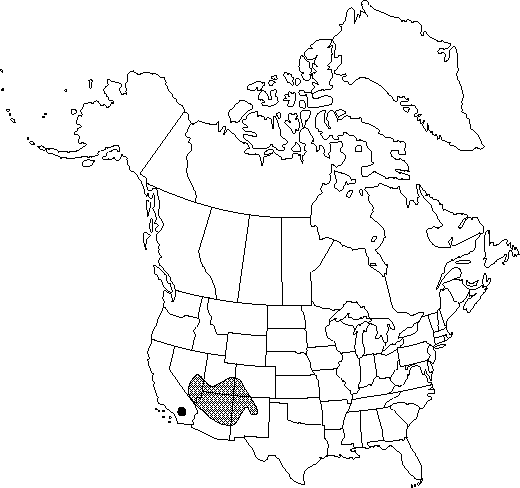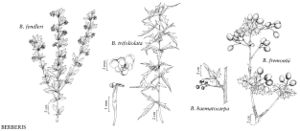Difference between revisions of "Berberis fremontii"
in W. H. Emory, Rep. U.S. Mex. Bound. 2(1): 30. 1859.
FNA>Volume Importer |
FNA>Volume Importer |
||
| Line 12: | Line 12: | ||
}}{{Treatment/ID/Special_status | }}{{Treatment/ID/Special_status | ||
|code=F | |code=F | ||
| − | |label= | + | |label=Illustrated |
}} | }} | ||
|basionyms= | |basionyms= | ||
| Line 18: | Line 18: | ||
|name=Mahonia fremontii | |name=Mahonia fremontii | ||
|authority=(Torrey) Fedde | |authority=(Torrey) Fedde | ||
| + | |rank=species | ||
}} | }} | ||
|hierarchy=Berberidaceae;Berberis;Berberis fremontii | |hierarchy=Berberidaceae;Berberis;Berberis fremontii | ||
| Line 43: | Line 44: | ||
-->{{#Taxon: | -->{{#Taxon: | ||
name=Berberis fremontii | name=Berberis fremontii | ||
| − | |||
|authority=Torrey in W. H. Emory | |authority=Torrey in W. H. Emory | ||
|rank=species | |rank=species | ||
| Line 57: | Line 57: | ||
|publication title=in W. H. Emory, Rep. U.S. Mex. Bound. | |publication title=in W. H. Emory, Rep. U.S. Mex. Bound. | ||
|publication year=1859 | |publication year=1859 | ||
| − | |special status=Endemic; | + | |special status=Endemic;Illustrated |
| − | |source xml=https://jpend@bitbucket.org/aafc-mbb/fna-data-curation.git/src/ | + | |source xml=https://jpend@bitbucket.org/aafc-mbb/fna-data-curation.git/src/f50eec43f223ca0e34566be0b046453a0960e173/coarse_grained_fna_xml/V3/V3_451.xml |
|genus=Berberis | |genus=Berberis | ||
|species=Berberis fremontii | |species=Berberis fremontii | ||
Revision as of 21:28, 16 December 2019
Shrubs evergreen, 1-4.5 m. Stems ± dimorphic, with elongate primary and short or somewhat elongate axillary shoots. Bark of 2d-year stems light brown or grayish purple, glabrous. Bud scales 2-4 mm, deciduous. Spines absent. Leaves 5-9(-11)-foliolate; petioles 0.2-0.8(-3) cm. Leaflet blades thick and rigid; surfaces abaxially dull, papillose, adaxially dull, glaucous; terminal leaflet stalked in most or all leaves, blade 1-2.6(-4) × 0.7-1.8(-2.5) cm, 1-2.5 times as long as wide; lateral leaflet blades elliptic to ovate or orbiculate, 1-3-veined from base, base obtuse or truncate, margins strongly crispate, toothed or lobed, with 2-5 teeth 2-6 mm high tipped with spines to 0.8-2.2 × 0.2-0.3 mm, apex obtuse to acuminate. Inflorescences racemose, lax, 3-6-flowered, 2.5-6.5 cm; bracteoles membranous, apex acuminate. Flowers: anther filaments with distal pair of recurved lateral teeth. Berries yellow or red to brown, ± glaucous, spheric, 12-18 mm, dry, inflated.
Phenology: Flowering spring (Apr–Jun).
Habitat: Slopes and flats in desert grassland and pinyon-juniper woodland
Elevation: 1100-2400(-3400) m
Distribution

Ariz., Calif., Colo., Nev., N.Mex., Utah.
Discussion
Berberis fremontii is susceptible to infection by Puccinia graminis.
The Apache Indians used Berberis fremontii for ceremonial purposes; the Hopi used it medicinally to heal gums (D. E. Moermann 1986).
Selected References
None.
